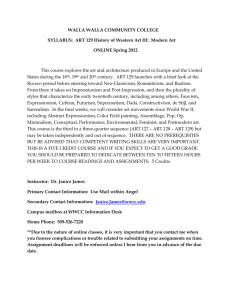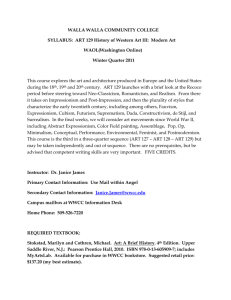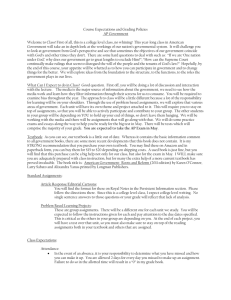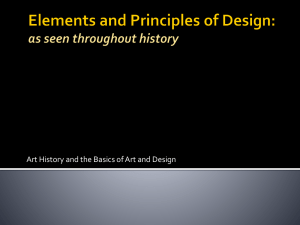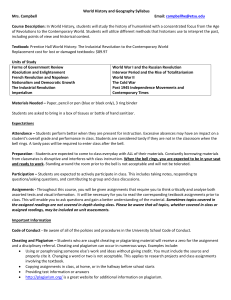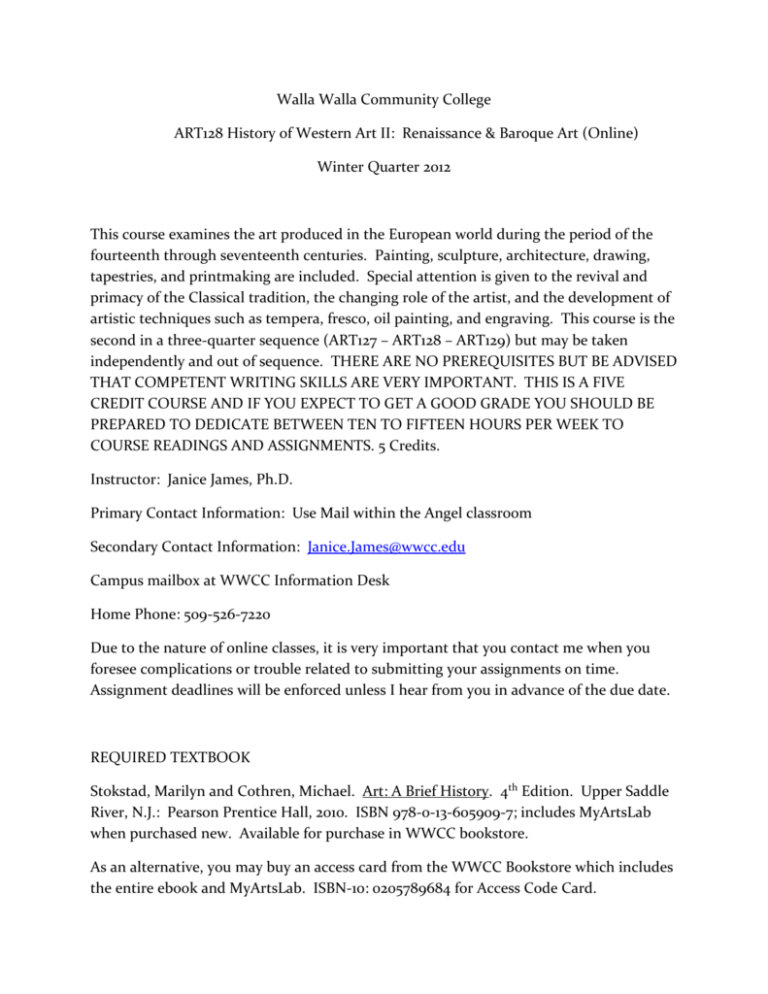
Walla Walla Community College
ART128 History of Western Art II: Renaissance & Baroque Art (Online)
Winter Quarter 2012
This course examines the art produced in the European world during the period of the
fourteenth through seventeenth centuries. Painting, sculpture, architecture, drawing,
tapestries, and printmaking are included. Special attention is given to the revival and
primacy of the Classical tradition, the changing role of the artist, and the development of
artistic techniques such as tempera, fresco, oil painting, and engraving. This course is the
second in a three-quarter sequence (ART127 – ART128 – ART129) but may be taken
independently and out of sequence. THERE ARE NO PREREQUISITES BUT BE ADVISED
THAT COMPETENT WRITING SKILLS ARE VERY IMPORTANT. THIS IS A FIVE
CREDIT COURSE AND IF YOU EXPECT TO GET A GOOD GRADE YOU SHOULD BE
PREPARED TO DEDICATE BETWEEN TEN TO FIFTEEN HOURS PER WEEK TO
COURSE READINGS AND ASSIGNMENTS. 5 Credits.
Instructor: Janice James, Ph.D.
Primary Contact Information: Use Mail within the Angel classroom
Secondary Contact Information: Janice.James@wwcc.edu
Campus mailbox at WWCC Information Desk
Home Phone: 509-526-7220
Due to the nature of online classes, it is very important that you contact me when you
foresee complications or trouble related to submitting your assignments on time.
Assignment deadlines will be enforced unless I hear from you in advance of the due date.
REQUIRED TEXTBOOK
Stokstad, Marilyn and Cothren, Michael. Art: A Brief History. 4th Edition. Upper Saddle
River, N.J.: Pearson Prentice Hall, 2010. ISBN 978-0-13-605909-7; includes MyArtsLab
when purchased new. Available for purchase in WWCC bookstore.
As an alternative, you may buy an access card from the WWCC Bookstore which includes
the entire ebook and MyArtsLab. ISBN-10: 0205789684 for Access Code Card.
MyArtsLab is an online resource provided by the publisher of your textbook. It is
described as “a robust online learning environment.” If you purchase a new textbook or
ebook, you will be able to link to MyArtsLab. In consideration of students who may buy a
used copy of the textbook, I do not require that you have or use MyArtsLab.
In the past students have bought used textbooks from Amazon.com. Also, at least one
student rented his textbook from an online source. I have included a link to a New York
Times article on the Course Announcement page which may suggest other useful options
if you do not intend to purchase a new book. If you do buy used, BE SURE TO
PURCHASE THE CORRECT EDITION OF THE BOOK (fourth edition).
It is critically important that you have a copy of the correct textbook in your possession
by the first day of class, January 3rd.
This class covers the Introduction, pages 292 to 414, and references to Classical art from
chapters 5 and 6. (Other portions of the textbook are used for ART127 – Ancient and
Medieval and ART129 – Modern Art).
COURSE GOALS
Upon successful completion of this course, you should be able to:
View art from the Renaissance and Baroque era with an enlightened
understanding, sensitivity, and curiosity
Distinguish various major artists, including Jan van Eyck, Giotto, Leonardo da
Vinci, Michelangelo, Raphael, Titian, Durer, Caravaggio, Rubens, Vermeer, and
Rembrandt, as well as major stylistic trends
Understand works of art in relation to the cultural and historical context in which
they were created, in particular, how the rise of Humanism, the Protestant Reformation,
the Counter-Reformation, scientific inquiry and global exploration influenced art
Develop an understanding of the concepts that define and distinguish the Western
visual tradition, especially the revival of Classical forms during the Italian Renaissance
Develop an understanding of the historical changes that transformed the
traditional roles of the artist and the patron
Be able to speak and write articulately and knowledgeably about Renaissance and
Baroque art
Nurture a long-lived interest in the arts and the places studies in this course
COURSE SCHEDULE
December 27: Course is open for viewing
Unit One/January 3-January 9: Introduction to the Course
Unit Two/January 10-January 16: Northern Renaissance Art
Unit Three/January 17-January 23: Renaissance Art in Italy
Unit Four/January 24-January 30: Italian Art of the High Renaissance
Unit Five/January 31-February 6: Venetian Art of the High Renaissance and Mannerism
Unit Six/February 7-February 13: MIDTERM EXAM
Unit Seven/February 14-February 20: High Renaissance Art in the North
Unit Eight/February 21-February 27: Baroque Art in Italy
Unit Nine/February 28-March 5: Baroque Art in Spain and Flanders
Unit Ten/March 6-March 12: Baroque Art in the Protestant Netherlands & Rococo
Unit Eleven/March 13-March 16: FINAL EXAM
UNIT COMPONENTS
Each weekly unit begins on Tuesday at 12:05 a.m. and ends the following Monday at 11:55
p.m. Please observe specific assignment deadlines.
In each weekly unit, you will find an assortment of components. I have tried to make
each unit basically consistent so that you will learn what to expect while allowing for
some variation. Unit Six is reserved for the Midterm exam, and the Final exam is
scheduled for Unit Eleven. As you will see, there are some modifications to suit these
special occasions. THIS CLASS IS DESIGNED FOR YOU TO RECALL COURSE
MATERIAL FROM EARLIER WEEKS, AND THE MIDTERM AND FINAL ARE ALSO
CUMULATIVE.
Each weekly unit contains:
READINGS from the textbook, Art: A Brief History. I consciously picked a
textbook that was not overly burdensome in regard to reading load and cost. As you will
see, I typically supplement textbook assignments with additional online readings.
EXPLORATORY ACTIVITIES are web visits added to enhance course topics.
WEEKLY GRADED ASSIGNMENTS include *multiple choice quizzes and art
vocabulary matching exercises based on the reading. An essay question (one or more),
**discussion forum, and ***mystery image (one or more) are also regularly included. The
Midterm and Final exams also include a discussion forum, mystery images, and/or essays.
*Multiple choice quizzes and art vocabulary matching exercises need to be
completed by Friday so that you will be familiar with unit concepts, issues, ideas,
artworks, and relevant vocabulary words which you are expected to use in your written
assignments (discussion forum posts, essays, and mystery images).
**A discussion forum is an interactive assignment designed for you to articulate
well-founded opinions and swap ideas with fellow students. You must post an initial
response and comment on TWO fellow students’ posts in order to get a passing grade. IT
IS IMPORTANT FOR YOU TO POST YOUR INITIAL RESPONSE WELL IN ADVANCE
OF THE UNIT DEADLINE IN ORDER TO GIVE FELLOW STUDENTS AMPLE
OPPORTUNITY TO COMMENT. Please note, therefore, that your initial post is due by
Friday and your two responses are due by Monday, 11:55 p.m. For a full credit (the highest
grade) your initial post and two replies need to be substantive (rich with meaning) and
well-written.
***A mystery image is a work of art that I presume you have not seen before, but
should be comfortable attributing to an artist or art historical period that we are studying
due to stylistic similarities, subject, technique, or another relatable measure. It may be
that you know or otherwise can positively identify the mystery image in which case you
must still be able to relate the mystery image to this course and relevant subjects under
study.
Angel provides Drop Boxes where you will submit answers to the essay questions
and mystery images written in Word. Before submitting a Word Document to Angel,
Save As “Word 97-2003” Document. By doing this, we can avoid potential computer
incompatibility issues. Always make a copy of your written assignments since we cannot
always predict what will happen in the cyber world between your computer and mine.
Please always safeguard against potential loss and always submit your assignment to the
correct Drop Box. (It becomes confusing when you don’t.)
LATE WORK POLICY: I strongly encourage you to abide by the posted deadlines and
submit your assignments on time. IF YOU ARE UNABLE TO MAKE A DEADLINE, YOU
NEED TO CONTACT ME VIA ANGEL EMAIL IMMEDIATELY. If I am notified, I will
tolerate a rare late submission; however, if I see a pattern of lateness emerging, I will warn
you and then impose a strict grade-demotion penalty for further lateness. If you can
foresee a problem or if an emergency arises, please contact me at once and together we
can arrange a mutually agreeable plan of action.
PLAGIARISM: Understand that plagiarism is a serious academic offense and will not be
tolerated. DO NOT SUBMIT ASSIGNMENTS CONTAINING TEXT THAT YOU HAVE
COPIED OR OBVIOUSLY MANIPULATED FROM YOUR TEXTBOOK OR ANY OTHER
SOURCE. Any instance of plagiarism will be dealt with severely. You will certainly get a
zero for that assignment, and disciplinary action from Walla Walla Community College
may be initiated. Repeat plagiarism (twice) earns an F in the class and an incident report
to WWCC administration, including the Financial Aid Office if applicable. The concept
of plagiarism also includes allowing another person to submit work in your name in the
class.
GRADING: Your final grade will be determined by calculating assignments based on the
following percentages: weekly quizzes and vocabulary matching exercises (10%),
discussion forums (15%), mystery images (15%), essays (20%), Midterm (20%), and Final
(20%).
A
100 – 93%
C
77 -73%
A-
92 – 90%
C-
72-70%
B+
89 -88%
D+
69 -68%
B
87 -83%
D
67-63%
B-
82 -80%
D-
62 -60%
C+
79 -78%
F
59% and below
To find links to information regarding specific WWCC policies related to Disabilities,
Plagiarism, and on-campus student support services, go to the Lessons tab and click on
TIPS and Course Resources.

